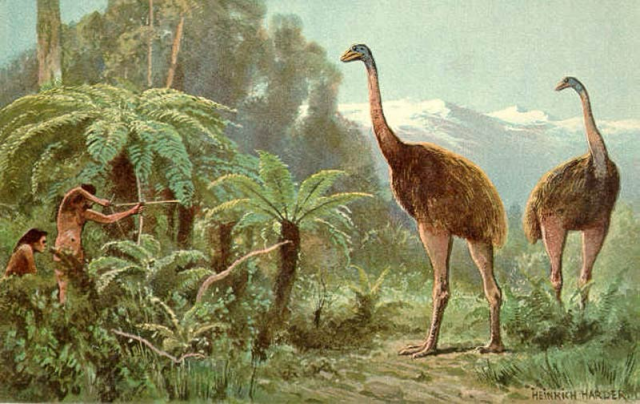Just 600 years ago, nine species of enormous, flightless birds called moas wandered around New Zealand. Some of these magnificent big birds grew up to 12 feet tall, which would tower over Sesame Street’s most famous resident.
Moas had thrived for millions of years. And suddenly - shortly after humans arrived on the islands - they went extinct.
Coincidence? #Science says no. science.org/content/article/wh… #history

John Breen
in reply to Sheril Kirshenbaum • • •Negative12DollarBill
in reply to Sheril Kirshenbaum • • •TeflonTrout
in reply to Sheril Kirshenbaum • • •SpaceLifeForm
in reply to Sheril Kirshenbaum • • •Cycling Stu
in reply to Sheril Kirshenbaum • • •spmatich vk3spm
in reply to Sheril Kirshenbaum • • •Two hundred years is quite a long time, from the arrival of the first people's to the last record of living Moa. So you would think if this occurred over 8-10 generations there would have been a period where the food source was harvested sustainably. If they had been a primary food source, people would have starved when the Moa died out. But after the Moa died out, indigenous people of NZ lived successfully for several hundred years until Europeans arrived. So they had other sources of food. They didn't need the Moa. They weren't dependent on it as a food source. As with any biological system involving humans, the story is probably a bit more complex than the article makes out. DNA analysis can reveal facts about genetic diversity, but not much about behavior.
Eric the half-a-bee
in reply to Sheril Kirshenbaum • • •#maori
#NewZealand
#moa
#aotearoa
WhichOne'sPink 🇫🇮
in reply to Sheril Kirshenbaum • • •MrsJ
in reply to Sheril Kirshenbaum • • •Brent Guernsey, Artrocity Studio
in reply to Sheril Kirshenbaum • • •🎵 If on Isle
You have found
twelve-foot birds
on the ground
That's a Moa...🎵
I...I'll see myself out.
#mastohumor
Ronnie Tucker
in reply to Sheril Kirshenbaum • • •Sheril Kirshenbaum
in reply to Ronnie Tucker • • •Andrea Casalotti
in reply to Sheril Kirshenbaum • • •Reftspin
in reply to Sheril Kirshenbaum • • •Pollinators
in reply to Sheril Kirshenbaum • • •rAdio frEe mETa
in reply to Sheril Kirshenbaum • • •